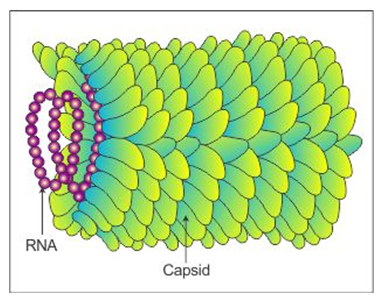Viruses, Viroids, AND Lichens
In the five kingdom classification of Whittaker, there is no mention of some acellular organisms like viruses and viroids, and lichens.
Viruses:

Viruses are @@non-cellular@@ organisms that are characterized by having ==an inert crystalline structure== outside the living cell.
- Once they infect a cell they take over the machinery of the host cell to replicate themselves, killing the host.
The name virus (venom or poisonous fluid) was given by @@Pasteur. D.J. Ivanowsky.@@
The Tobacco Mosaic Virus was found to be smaller than bacteria because they passed through bacteria-proof filters.
- ^^M.W. Beijerinek^^ demonstrated that the extract of the infected plants of tobacco could cause infection in healthy plants and is called the fluid ^^Contagium vivum fluidum.^^
@@W.M. Stanley@@ @@showed that@@ @@viruses could be crystallized@@ @@and crystals consist largely of@@ @@proteins@@.
- They are inert outside their specific host cell.
- They are @@obligate parasites.@@
- Viruses also contain genetic material, that could be ==either RNA or DNA== but never both.
- Viruses are nucleoproteins and the genetic material is infectious.
- Viruses that ==infect plants have single-stranded RNA== and viruses that @@infect animals have either single or double-stranded RNA or double-stranded DNA.@@
- Bacterial viruses or bacteriophages (viruses that infect bacteria) are usually double-stranded DNA viruses.

The ==protein coat called capsid== made of small subunits called @@capsomeres protects the nucleic acid.@@
- These capsomeres are arranged in helical or polyhedral geometric forms.
Viruses cause diseases like mumps, smallpox, herpes, AIDS, and influenza.
In plants, the symptoms can be:
- @@The mosaic formation@@
- @@leaf rolling and curling@@
- @@yellowing and vein clearing@@
- @@dwarfing@@
- @@stunted growth.@@
Viroids:
- ^^T.O. Diener^^ discovered a new infectious agent that was smaller than viruses and %%caused potato spindle tuber disease.%%
- It was found to be a ^^free RNA.^^
- It %%lacked the protein coat%% that is found in viruses.
- The ^^RNA of the viroid was of low molecular weight^^^^.^^
Lichens:
- They are symbiotic associations i.e. mutually useful associations, @@between algae and fungi.@@
- The algal component is known as @@phycobiont@@ and the fungal component is @@mycobiont@@@@,@@ which is autotrophic and heterotrophic, respectively.
- @@Algae prepare food@@ for fungi and @@fungi provide shelter@@ and absorb mineral nutrients and water for their partner.
- Lichens are very good pollution indicators – they do not grow in polluted areas.